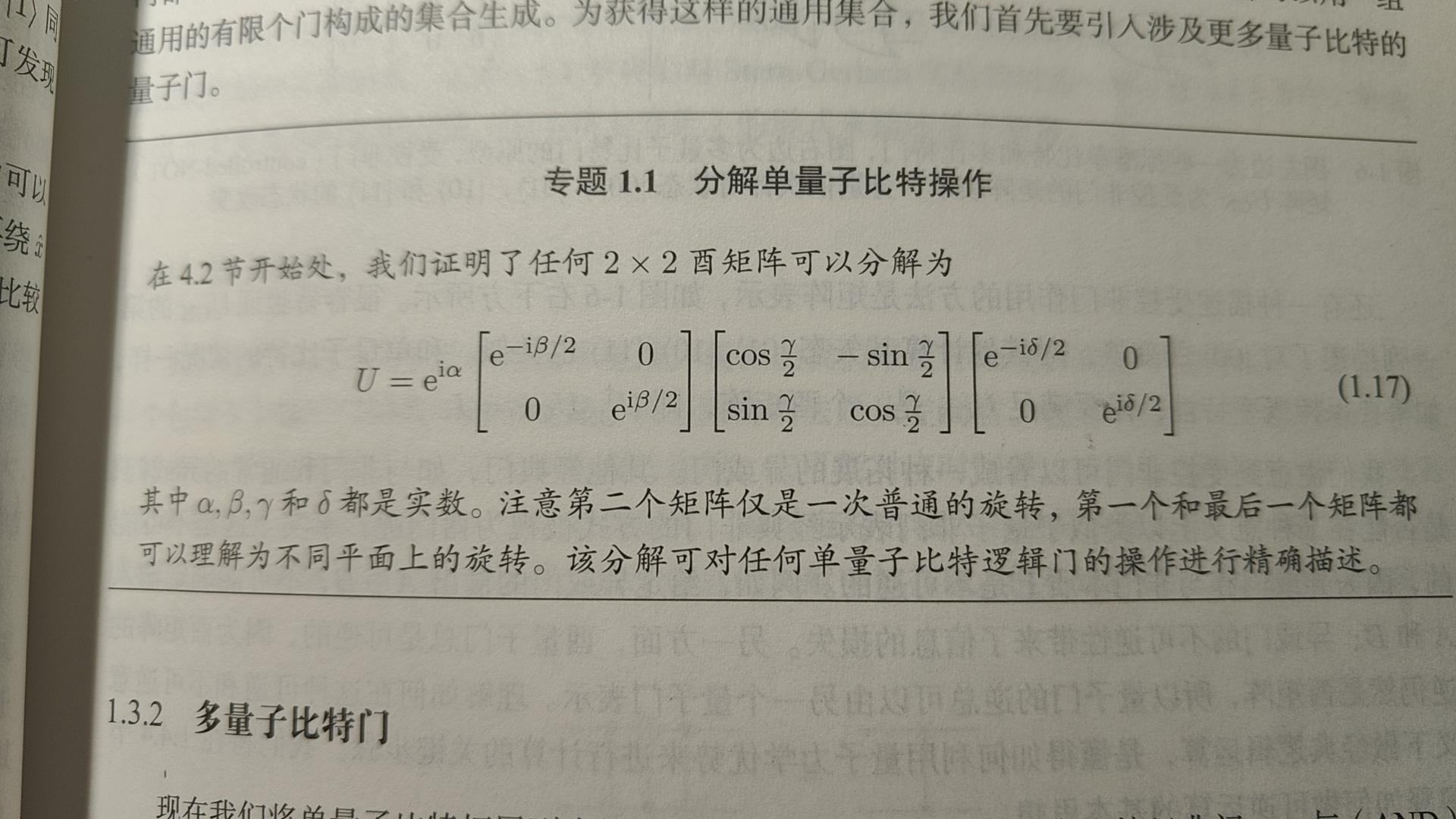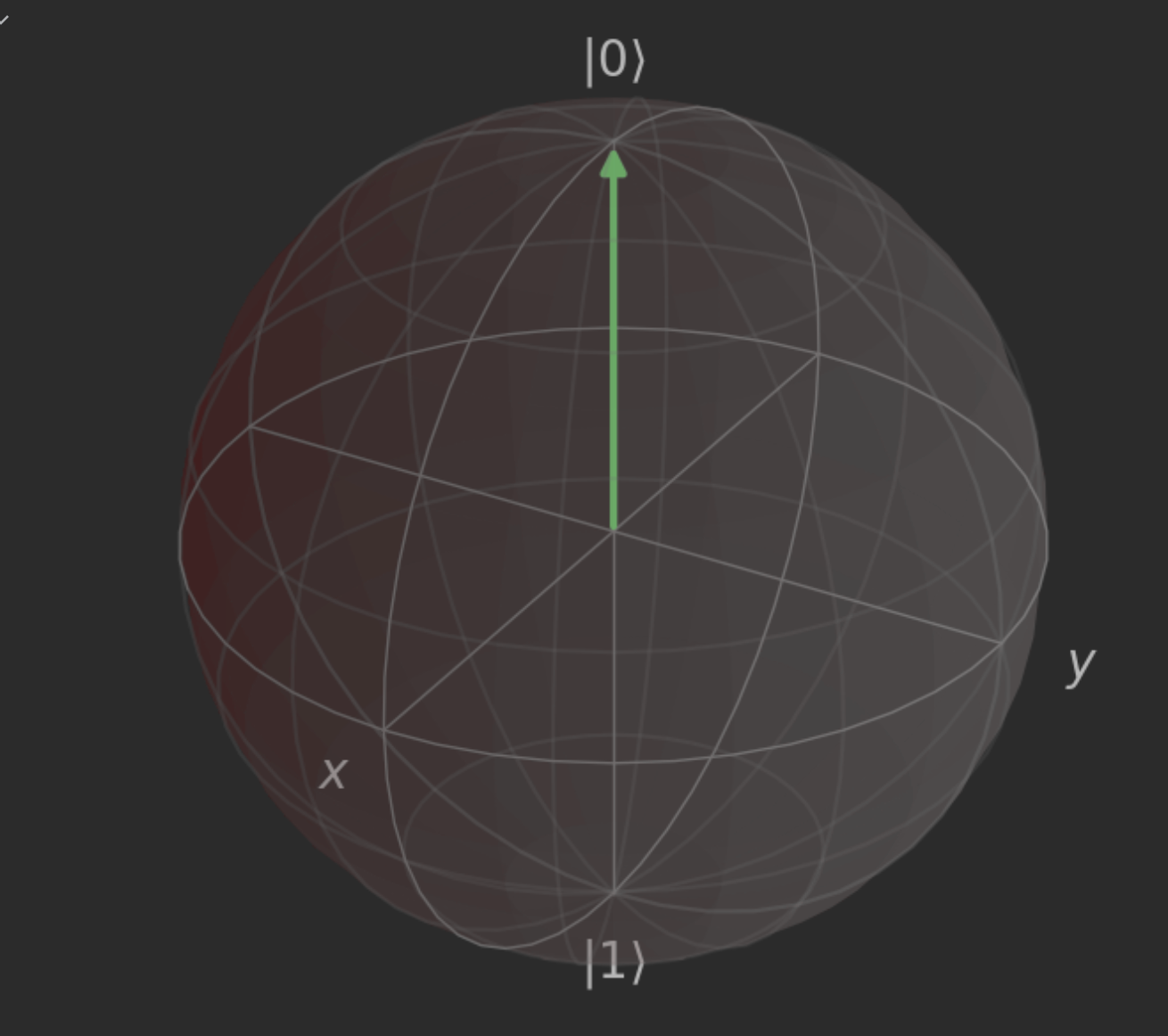作业二:幺正变换与Bloch球
原创2023/2/24大约 4 分钟...约 1182 字
作业二:幺正变换与 Bloch 球
###### -- QUANTA -- #######
# Author: Y. Liu, W. Shi #
# Data: 2022-09-17 #
###########################
from qutip import *
from scipy.linalg import *
from mpl_toolkits.mplot3d import Axes3D
import numpy as np
import matplotlib.pyplot as plt第一步:证明
提交纸质作业(照片或扫描件),粘贴到该文本中

第二步:U 矩阵的解析与重建
完善以下代码:
def resolveUnitary(U):
alpha = 0.0000
n = np.array([0.0000, 0.0000, 1.0000], dtype = float)
theta = np.pi/4
#######################################
#todo: modify the following code to complete this function. The initial values are assigned manually
#######################################
U_params = {'alpha': alpha, 'n': n, 'theta': theta}
return U_params
def rebuildUnitary(U_params):
alpha = U_params['alpha']
n = U_params['n']
theta = U_params['theta']
#######################################
#todo: modify the following code to complete this function. The initial values are assigned manually
#U = np.array([[1.0000 + 0.0000j, 0.0000 + 0.0000j],[0.0000 + 0.0000j, 1.0000 + 0.0000j]], dtype = complex)
#######################################
return U测试代码
请同学们直接运行以下代码块检查所实现函数的正确性
注:同学们可参考测试数据,但请勿修改测试代码!
#don't modify the code in this block
n_ck = 10
U_ck = np.array([[[-0.6707 + 0.6665j, 0.2031 - 0.2545j],
[-0.0453 + 0.3224j, -0.0234 + 0.9452j]],
[[ 0.8792 + 0.0575j, -0.1825 + 0.4364j],
[ 0.4730 - 0.0043j, 0.2785 - 0.8359j]],
[[-0.5751 - 0.6049j, 0.1465 - 0.5310j],
[ 0.5344 - 0.1332j, -0.5904 - 0.5900j]],
[[ 0.4716 - 0.6140j, 0.1917 - 0.6032j],
[-0.6234 - 0.1099j, 0.7627 - 0.1330j]],
[[ 0.5559 + 0.8131j, -0.0088 - 0.1725j],
[ 0.1709 + 0.0247j, 0.7583 + 0.6286j]],
[[ 0.8838 - 0.4675j, -0.0088 + 0.0181j],
[-0.0140 + 0.0144j, -0.1410 + 0.9898j]],
[[-0.0874 + 0.8127j, 0.0353 - 0.5750j],
[-0.1685 + 0.5509j, -0.2030 + 0.7918j]],
[[-0.4976 - 0.7870j, -0.3288 + 0.1578j],
[ 0.1857 + 0.3138j, -0.8510 + 0.3778j]],
[[-0.1367 + 0.8515j, -0.3078 - 0.4018j],
[ 0.0605 - 0.5026j, -0.5511 - 0.6634j]],
[[ 0.2000 + 0.5090j, 0.4764 - 0.6885j],
[-0.7248 - 0.4191j, -0.0365 - 0.5456j]]], dtype = complex)
U_params_ck = [ { 'alpha' : 5.1191, 'n' : np.array([-0.1790, -0.6547, 0.7344], dtype=float), 'theta' : 5.2824},
{ 'alpha' : 5.6913, 'n' : np.array([-0.3633, 0.5512, -0.7512], dtype=float), 'theta' : 1.5977},
{ 'alpha' : 0.7979, 'n' : np.array([ 0.8633, 0.5043, 0.0194], dtype=float), 'theta' : 5.1163},
{ 'alpha' : 5.7389, 'n' : np.array([ 0.6018, -0.6878, 0.4059], dtype=float), 'theta' : 1.5301},
{ 'alpha' : 3.9732, 'n' : np.array([-0.4976, -0.6054, 0.6212], dtype=float), 'theta' : 5.8387},
{ 'alpha' : 0.6129, 'n' : np.array([-0.0223, -0.0036, 0.9997], dtype=float), 'theta' : 2.1990},
{ 'alpha' : 1.7499, 'n' : np.array([-0.1169, 0.9879, 0.1015], dtype=float), 'theta' : 1.2352},
{ 'alpha' : 3.4362, 'n' : np.array([ 0.3473, -0.3789, -0.8578], dtype=float), 'theta' : 1.5776},
{ 'alpha' : 6.0162, 'n' : np.array([ 0.5018, 0.2044, -0.8405], dtype=float), 'theta' : 3.8707},
{ 'alpha' : 6.0626, 'n' : np.array([ 0.5696, -0.6177, -0.5423], dtype=float), 'theta' : 2.9738} ]
def checkResolveUnitary():
print("Check unitary resolving...")
err = 0.0000
for it in range(n_ck):
U_dict = resolveUnitary(U_ck[it])
a_diff_1 = abs(U_dict['alpha'] - U_params_ck[it]['alpha'])
n_diff_1 = np.sum(abs(U_dict['n'] - U_params_ck[it]['n']))
t_diff_1 = abs(U_dict['theta'] - U_params_ck[it]['theta'])
a_diff_2 = abs(abs(U_dict['alpha'] - U_params_ck[it]['alpha']) - np.pi)
n_diff_2 = np.sum(abs(U_dict['n'] + U_params_ck[it]['n']))
t_diff_2 = abs(U_dict['theta'] + U_params_ck[it]['theta'] - 2 * np.pi)
err = err + min(a_diff_1 + n_diff_1 + t_diff_1, a_diff_2 + n_diff_2 + t_diff_2)
if err < 0.01:
print('Pass!')
else:
print('Wrong Answer err = %.3f! Please Correct the code.' % err)
def checkRebuildUnitary():
print("Check unitary rebuilding...")
err = 0.0000
for it in range(n_ck):
U = rebuildUnitary(U_params_ck[it])
err = err + np.sum(abs(U - U_ck[it]))
if err < 0.01:
print('Pass!')
else:
print('Wrong Answer err = %.3f! Please Correct the code.' % err)
checkResolveUnitary()
checkRebuildUnitary()第三步:幺正变换的绘制
下面的代码将的作用效果绘制在Bloch球上。修改代码完成幺正变换的旋转轴绘制
fig = plt.figure(figsize=(6,6))
axes = Axes3D(fig, auto_add_to_figure=False)
fig.add_axes(axes)
sphere = Bloch(axes = axes)
#example:
U = np.array([[2**(-0.5), 2**(-0.5)], [2**(-0.5), -2**(-0.5)]], dtype = complex)
U_p = resolveUnitary(U)
sphere.add_vectors(U_p['n'])
U_1 = np.array([[0.3536 + 0.6124j, 0.6124 - 0.3536j],
[0.6124 - 0.3536j, 0.3536 + 0.6124j]], dtype = complex)
psi_1 = np.array([[0.7337 + 0.0000j], [0.5213 + 0.4358j]], dtype = complex)
psi_2 = np.matmul(U_1, psi_1)
######################
#todo:
#plot the rotation axis of U_1, psi_1, psi_2 onto the Bloch sphere
#Note: there is an overall phase in U_1, which is passed to psi_2
######################
sphere.make_sphere()
#when using CMD to run this script, the Bloch sphere can be shown in an independent view by the following code.
#fig.show()
第四步: 任意 U 矩阵的 ZYZ 分解
完成下面的代码,实现任意酉矩阵的Z-Y-Z分解:$$U=e^{i\alpha}R_z(\beta)R_y(\gamma)R_z(\delta)$$
def R_z(theta):
return np.matrix([[np.exp(-1j * theta / 2), 0],[0, np.exp(1j * theta / 2)]])
def R_y(theta):
return np.matrix([[np.cos(theta/2), -np.sin(theta/2)],[np.sin(theta/2), np.cos(theta/2)]])
def R_x(theta):
return np.matrix([[np.cos(theta/2), -1j * np.sin(theta/2)], [-1j * np.sin(theta/2), np.cos(theta/2)]])
def ZYZ_Decomp(U):
alpha = 0.0000
beta = 0.0000
gamma = 0.0000
delta = 0.0000
#######################################
#todo: modify the following code to complete this function. The initial values are assigned manually
#######################################
return [alpha, beta, gamma, delta]测试 ZYZ 分解
U_ck_zyz = np.array([[-0.5000 + 0.5000j, 0.7071 - 0.0000j],
[-0.7071 + 0.0000j, -0.5000 - 0.5000j]], dtype = complex)
p = ZYZ_Decomp(U_ck_zyz)
U_reb = np.exp(1j * p[0]) * R_z(p[1]) * R_y(p[2]) * R_z(p[3])
err = np.sum(abs(U_reb - U_ck_zyz))
if err < 0.01:
print('Pass')
else:
print('Wrong Answer err = %.3f! Please Correct the code.' % err)公众号:AI悦创【二维码】

AI悦创·编程一对一
AI悦创·推出辅导班啦,包括「Python 语言辅导班、C++ 辅导班、java 辅导班、算法/数据结构辅导班、少儿编程、pygame 游戏开发、Web、Linux」,全部都是一对一教学:一对一辅导 + 一对一答疑 + 布置作业 + 项目实践等。当然,还有线下线上摄影课程、Photoshop、Premiere 一对一教学、QQ、微信在线,随时响应!微信:Jiabcdefh
C++ 信息奥赛题解,长期更新!长期招收一对一中小学信息奥赛集训,莆田、厦门地区有机会线下上门,其他地区线上。微信:Jiabcdefh
方法一:QQ
方法二:微信:Jiabcdefh

更新日志
2025/4/11 07:49
查看所有更新日志
1c35a-于aed17-于01745-于256c7-于d2803-于1dd16-于e942f-于cbb3a-于610fe-于c3e95-于74e60-于ffdaf-于b89f1-于c7430-于76989-于86c50-于027da-于
贡献者
AndersonHJBAI悦创